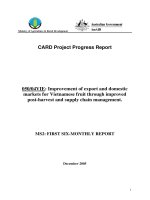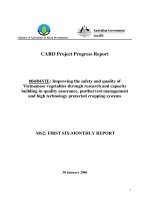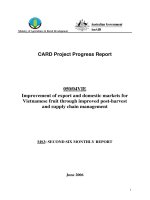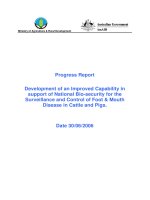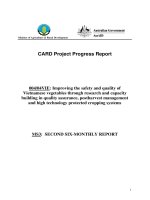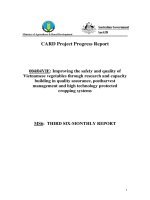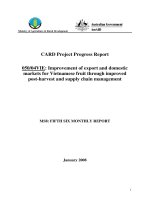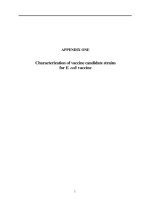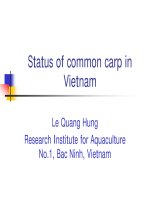Báo cáo nghiên cứu khoa học " Improvement of export and domestic markets for Vietnamese fruit through improved post-harvest and supply chain management - MS2 " docx
Bạn đang xem bản rút gọn của tài liệu. Xem và tải ngay bản đầy đủ của tài liệu tại đây (470.56 KB, 28 trang )
Ministry of Agriculture & Rural Development
CARD Project Progress Report
050/04VIE: Improvement of export and domestic
markets for Vietnamese fruit through improved
post-harvest and supply chain management.
MS2: FIRST SIX-MONTHLY REPORT
December 2005
1
1. Institute Information
Project Name
Improvement of export and domestic markets for
Vietnamese fruit through improved post-harvest and
supply chain management.
Vietnamese Institution
Southern Sub-Institute of Agricultural Engineering and
Post-Harvest Technology (SIAEP)
Vietnamese Project Team Leader
Mr Nguyen Duy Duc, M. Eng.
Australian Organisation
Queensland Department of Primary Industries and
Fisheries (DPI & F)
Australian Personnel
Mr. Robert Nissen; Dr. Peter Hofman
Mr Brett Tucker; Mr. Roland Holmes
Mss Marlo Rankin
Date commenced
June 2005
Completion date (original)
May 2008
Completion date (revised)
June 2008
Reporting period
Inception Report:- 1
st
Six-monthly report June 2005 to
December 2005
Contact Officer(s)
In Australia: Team Leader
Name:
Mr. Robert Nissen
Telephone:
+61 07 54449631
Position:
Project Leader
Fax:
+61 07 54412235
Organisation
Queensland Department
of Primary Industries
and Fisheries (DPI & F)
Email:
In Australia: Administrative contact
Name:
Michelle Robbins
Telephone:
+61 07 3346 2711
Position:
Senior Planning
Officer
(Emerging
Technologies)
Fax:
+61 07 3346 2727
Organisation
Queensland
Department of
Primary
Industries and
Fisheries (DPI &
F)
Email:
michelle@
In Vietnam
Name:
Mr Nguyen Duy Duc,
Telephone:
+84 (8) 8481151
2
Position:
Director SIAEP
Fax:
+84 (8) 8438842
Organisation
Southern Sub-Institute of
Agricultural Engineering and
Post-Harvest Technology
(SIAEP)
Email:
3
2. Project Abstract
The fruit industry in Vietnam has a great potential and plays an important role in
agricultural production. Vietnam is experiencing difficulties in competing with other
Asian nations in export markets and its own domestic market, especially with China and
Thailand. This suggests that horticultural industries require substantial development to be
globally competitive. This project aims to fill capacity gaps and reduce major weaknesses
in pre-and post-harvest technology, product quality and consistency, cluster organisation
and supply chain management and planning. Highly specialised targeted training
programs for government and industry stakeholders will be provided. This project
addresses serious constraints through identifying key Vietnamese stakeholders and
empowering them to focusing on the total supply chain network, and identifying where
benefits are to be gained. In addition, if quality management systems are implemented,
greater employment will be provided for the farming community. This project embraces
the five CARD strategies for rural development; and in particular; strategies to increase
production and competitiveness of agricultural systems; reduce poverty and vulnerability,
and increase stakeholder participation whilst ensuring sustainability.
3. Executive Summary
Significant information gathering on mango and pomelo internationally, country wide
and locally has been initiated by Australian and Vietnamese collaborators.
Globalisation is having an affect on agribusiness practices causing significant and
dramatic change. It is imperative that these factors be taken into account during this
project.
Significant linkages to other CARD Projects have been made with discussions being
held with the Hort Research Dragon Fruit Project manager Mr John Campbell as well
as the AADCP Program Stream: Quality Assurance Systems for ASEAN Fruit and
Vegetables.
Five workshops were designed and presented to collaborators SOFRI and SIAEP in
November 2005.
A further six workshops on this CARD project, aims, objectives and benefits to
stakeholders were also held in November 2005 for potential project stakeholders and
farmer groups.
Workshops were conducted to inform potential stakeholders of project aims,
objectives and benefits to smallholders who will participate in this CARD Project.
Discussions with farmer groups, collectors and traders were well received.
Significant problems exist at the farmer level with pre-harvest production issues.
4
Problems in obtaining high quality fruit due to tree size, pest and disease control
management systems and lack of quality control systems at the farm level were
identified.
A workshop to discuss projects constraints and impediments, and proposed
methodologies for meeting the next 6 monthly objectives for this project was
conducted. Processes and details on the strategic planning for the operational delivery
of technical training programs in the value chain that supports the growth of
Vietnamese domestic and export markets for mangos and pomelos were discussed.
Books purchased from Australian funds were presented to Vietnamese collaborators
at SIAEP, SOFRI and Nha Trang. All material supplied is under copyright of
QDPI&F but relevant information will be extracted and incorporated into manuals
that are applicable to Vietnamese conditions. New books will be developed and
written in Vietnamese for both the mango and citrus (pomelo) industries in Vietnam
as per the CARD project log frame.
One electronic copy of the Agrilink Mango Information Kit produced by DPI&F has
been translated into Vietnamese’s and handed to SIAEP and SOFRI staff to conduct
training of stakeholders in Vietnam.
Regular meetings have been held with Australian project team members as well as
regular information exchanges via email with Vietnamese collaborators to determine
if changes are needed to be made to the objectives, outputs and activities. These
meetings determined that the process outlined in the approved CARD Project
document is still valid and no change is needed. These meetings also determined the
processes to obtain good agricultural practices (GAP) and development of best
practice manuals (BPM) for pre and post harvest production, supply chain
development and management, for mango and pomelo.
Both, Australian and Vietnamese collaborators were in agreement, that Adult
Learning Processes, such as the use of Participatory Action Learning (PAL) and Train
the Trainer (TTT) is the most appropriate methods to use. Train the trainer (TTT) will
ensure that new concepts and methodologies (knowledge, information and training
tools) provided by the Australian team members to collaborating Vietnamese
institutes (SOFRI and SIAEP) will improve the projects effectiveness and
sustainability by providing a resource through which the Vietnamese mango and
pomelo industries can utilise.
Pollution is a problem, particularly in the Mekong Delta. The culture and attitudes of
the farming population and villages, especially the poor need to be changed. To
reduce environmental degradation, villages need to be educated
IMP strategies to reduce of agricultural pesticide use and maximise the use of
biological and cultural controls, rather than a strict chemical control method is
5
needed. Chemicals must play a supportive rather than dominant role. Pesticides
should be used strictly when needed, as determined by pest monitoring systems and
natural enemies encouraged providing a means of control. The use of selective, non-
disruptive chemicals must be preferred over broad-spectrum chemicals that can create
an in-balance in orchards.
The market opportunities created by doi moi have stimulated the diversification of
agricultural production and the development of Vietnam’s agro-industries. In
agricultural, forestry and fishery production, women participate in farming with
production based on village/family units with all family members contributing to pre-
harvest management. Vietnam is a poor country in which 80 percent of the
population lives in the rural areas. Women account for the majority in rural
population (about 52%) and rural workforce (52-54%). Thus women make great
contribution to rural economic growth.
4. Introduction & Background
The Vietnamese government set a target of reaching US$1 billion in exports by 2010.
Eleven fruits are reported to have export potential including mango and pomelo.
However, drops in exports by 30% reveal a need to develop competitive supply chains
due to wider global trends and competition with China and Thailand (VCNI, USAID
Report 2003 & Ford et al., (2003)). Ford et al., (2003) analysed the competitiveness
of fruit industries of Vietnam and identified poor and unstable product quality, no
quality standards, poor post-harvest technologies and pre-harvest practices, lack of
group or co-operative marketing structures and little information about supply, prices
and customer needs as serious constraints to the development of fruit and vegetable
industries in Vietnam.
This project addresses these serious constraints through identifying key Vietnamese
stakeholders from both the government and industry sectors. It will then engage and
empower them by focusing on the total supply chain network, and identifying where
benefits are to be gained. The project will fill capacity gaps and reduce major
weaknesses in post-harvest technology, product quality and consistency, cluster
organisation and supply chain management and planning. This project will also
provide highly specialised targeted training programs appropriate for government and
industry stakeholders.
The proposed approach involves a whole of supply chain or cluster approach, driven
by identification of consumer needs (domestic and export) for the mango and pomelo,
building on published and unpublished research work and incorporates advanced
technology transfer to improve pre- and post-harvest quality of mangoes and pomelo,
while at the same time attempting to improve farm incomes by empowering growers
to form groups. The key components are:
• Selection of the key stakeholders and identification of key pre and
post-harvest and cultural constraints
• Mapping and identifying strengths and weaknesses in existing
domestic and export chains for mango and pomelo, with particular
6
emphasis on determining consumer preferences and needs, and feeding
results back to farmers.
• Developing improved export and domestic supply chains for mango
and pomelo
• Setting up of new, improved farmer groups/organisations for exporting
The ‘training the trainer’ approach has been only been partially successful in
transferring technology due to the variability in technical understanding and
performance of the extension officers (George et al., 2004). Therefore, we believe
that it will be highly essential that farmers also receive full training. Training will be
conducted through workshops, small group processes, demonstration blocks and
individually.
The beneficiaries are mango and pomelo supply chain members – farmers, traders,
transporters, wholesalers, exporters, and consumers. There are also indirect benefits
to Government Staff, through a better understanding of supply chain function, and
through advanced technology transfer as well as the strengthening of cooperative
relationships between SIAEP, SOFRI, Vinafruit and the Agriculture Departments of
three provinces etc., and improved technical expertise through international linkages.
It is envisaged that trained specialists, capable of undertaking industry analysis and
possessing the practical ability to identify problems areas in the supply chains. They
will have the ability to deliver knowledge in supply chain management. The will need
to also solve supply chain problems to enhance Vietnamese Fruit Industries. Also
greater cooperation, cohesiveness, improved practices along the supply chain
providing an increased financial benefit to all participants for the small farmers, to the
exporter to the retailer.
In terms of risk management, there should be little risk in transferring appropriate
technology (pre- and post-harvest management techniques), as long as due
consideration is given to the capacity of farmers to adapt such technology to use on
their own farms. In addition, integrated pest and disease management systems should
lead to decreased pesticide residues, and improve human health and better
environmental outcomes. We are therefore promoting biological control and
bioproducts by applying best management practices.
5. Progress to Date
5.1 Implementation Highlights
INFORMATION GATHERING
Due to fast changing nature of agribusiness practices, primarily due to globalisation
affects, it has been imperative from the projects perspective and inception, that
identification of new information published on:
• mango and pomelo pre- and post-harvest production and marketing issues
7
• agricultural supply chains (analysis, development processes, and design) be
included in this project.
Generic supply chain analysis and development processes have changed recently to
one of creating value for participants in the supply chain, therefore supply chains are
now being transformed into value chains.
Some examples of information sourced:-
• FAO stats on mango and pomelo production, tonnages, exports and imports,
consumption patterns for Asia and major producing countries in the world.
(study effects on Vietnamese mango and pomelo industries and competitive
analysis as per CARD Project log frame)
• DPI&F articles, greater than 23 articles on pre-and post-harvest aspects of
mango and citrus production (Information to be used for development of pre-
and post-harvest manuals and quality assurance manuals)
• Over 50 web published articles and presentation on supply chain analysis,
processes and design reviewed from USA and Europe and Australia
o For example Australian material on supply chains:-
National Food Industry strategy- Food Chain Capability
Development Program (Australian)
Australian Centre for International Agricultural Research
(ACIAR) Agri-product Supply Chain management in
Developing Countries ,workshop proceedings Bali, Indonesia,
19-22
nd
August, 2003
Rural Industries Research and Development Corporation
(RIRDC) Supply Chain Management – Building partnerships
and alliances in international food and agribusiness, April,
2001.
Furthermore, Vietnamese documents such as the Vietnamese Agricultural Planning
document, Socioeconomic documents identified, sourced and relevant information
extracted.
For example:-
• Vietnam’s trade policies 1998, Centre for International Economics Canberra &
Sydney December 1998.
• Master plan for Agricultural Research in Vietnam UNDP/FAO VIE 98/019.08
Hanoi, June 2001.
• Fruit and Vegetables in Vietnam-Adding Value from Farmer to Consumer,
July 2002, prepared by the International Food Policy Research Institute.
• The regional Poverty Assessment Mekong River Region, March 2004,
prepared by UNDP and AUSAID.
• A guide to Identifying Market Opportunities for Rural Smallholder Producers,
a Rural Agro-Enterprise Development Project, International Centre for
Tropical Agriculture (CIAT).
Much of this research was undertaken by the Australia team to ensure up to date
information is sourced, extracted and compiled for inclusion in training material and
to improve the knowledge base of the Vietnamese collaborators. Similarly, our
Vietnamese’s collaborators are also identifying, sourcing, and evaluating published
material suitable for inclusion in this CARD Project. This information being sourced
will ensure that this CARD project will build capacity in the Vietnamese
8
collaborators. By removing out of date information, decisions are based on reliable
and up to date information, therefore ensuring sustainable CARD project outcomes.
PROJECT LINKAGES
Linkages to other projects and these include:-
Agency Project No Project Title
Queensland Department of
Primary Industries and
Fisheries (DPI&F)
PN94/947
Adaptation of low-chill temperate fruit to Australia and
Thailand. Project initiated in 1996 and completed in
1999.
Queensland Department of
Primary Industries and
Fisheries (DPI&F)
PN2127 Adaptation of low-chill temperate fruits to Thailand,
Laos, Vietnam and Australia. Project initiated in 2001
and completed in June 2004. Extension initiated in
June 2004 and work is continuing in Thailand and
Laos.
World Vision Project CTE/2000/165 Facilitating farmer uptake of ACIAR project results:
temperate fruit orchards for quality of life development
in Chiang Rai province. This project is continuing but
urgently needs technical support by DPI&F to be
successful.
New South Wales
Department of Agriculture
PHT/2002/086 Improving post harvest quality of temperate fruits in
Vietnam and Australia. Project initiated in June 2004 .
CIAT ADP/2001/066 Strengthening agricultural market information
activities in Vietnam.
UQ School for Natural
Resources
CARD Project Improving the performance of the fruit industry in the
Tien Giang and Tra Vinh Provinces in Mekong Delta.
AADCP Program Stream Project Design
Document –May
2004
Quality Assurance Systems for ASEAN Fruit and
Vegetables.
ADB Project VIE-1781 Development project of tea and fruits, MARD, Asian
Development Bank
Ministry of Science and
Technology
NA Collaboration of post-harvest handling and fruit market
promotion between Vietnam and Thailand
HortResearch Dragon Fruit Project
HortResearch has initiated a two year project in Vietnam, funded by AusAID. This
project is to help the local Dragon Fruit industry develop Good Agriculture Practice
(GAP) systems and allow them to achieve accreditation to EUREPGAP standards.
This will enable the Vietnamese dragon fruit industry to export fruit to the high-value
European market. Whilst at SOFRI in south Vietnam in November 2005, Mr. Nissen,
Mr. Tucker and Miss Rankin made contact with Mr. John Campbell of HortResearch.
Mr. Campbell was conducting training on Quality Assurance in the Dragon Fruit
Supply Chain. Brief discussions held between Mr. Nissen and Mr. Campbell on
project outlines of quality assurance training to be undertaken in each project. A
9
verbal agreement was made to undertake further communications and develop
information flows between both projects on quality assurance aspects.
AADCP Program Stream Project
AADCP Program Stream: Quality Assurance Systems for ASEAN Fruit and
Vegetables. The quality assurance aspects and issues in this project have been
incorporated and modified for this CARD project with permission from the AADCP
Program Stream Project personnel. QDPI&F personnel have developed the quality
assurance training manuals and processes as well as carrying out quality assurance
training in Vietnam. Linkage with this project has ensured that a united message is
being delivered to all Vietnamese collaborators. This avoids mixed messages being
delivered, removing any confusion as to what constitutes quality assurance. This
project linkage will ensure sustainability outcomes for this CARD project.
TRAINING UNDERTAKEN AND CAPACITY BUILDING
Australian Personnel Travel
Three Australian personnel travelled to Vietnam for a scheduled project visit of two
weeks. Team members were Mr. Nissen Mr. Tucker, Mss Rankin. The trip was
undertaken in late November 2005 (14
th
to 29
th
November) to conduct training
workshops, on methodologies and approaches to undertake supply chain analysis
• what is a supply chain?
• how to segment a supply chian to obtain information on product, information,
monetary and quality flows along the supply chain
• quality monitoring and sampling along the supply chain
• interview techniques and questionnaire design, team building exercises and
conflict resolution methodology and processes.
TRAINING WORKSHOPS
Five workshops were designed and presented to collaborators SOFRI and SIAEP in
November 2005. A further six workshops on this CARD project, aims, objectives and
benefits to stakeholders were also held in November 2005 for potential project
stakeholders and farmer groups in
• Tein Gian Province
• Vinh Long Province
• Khanh Hoa Province
• and Ho Chi Minh City Region (See 5.2 Smallholder Benefits).
Capacity building workshops were conducted in Ho Chi Minh City for staff of SIAEP
and SOFRI in November 2005 (See section 5.3 Capacity Building).
MATERIAL SUPPLIED AND INFORMATION EXCHANGED
Books purchased from Australian funds were presented to Vietnamese collaborators
at SIAEP, SOFRI and Nha Trang. All material supplied is under copyright of
QDPI&F but relevant information will be extracted and incorporated into manuals
that are applicable to Vietnamese conditions. New books will be developed and
written in Vietnamese for both the mango and citrus (pomelo) industries in Vietnam
as per the CARD project log frame. Information to be supplied will provide
workshop outlines, and topics will include details on pre-and post-harvest production
and marketing issues as well as supply chain management.
10
Books (Hard Copy)
Agrilnk Mango Information Kits:- Sent four copies of the QDPI&F Agrilink
Mango Information Kit is a best practice manual developed for mango farmers in
Australia. Agrilink is built around several important principles. This product
focuses on the core information that is most needed and regularly sought by first
time and intermediate farmers. This is approximately a 250 page manual. Issues
and areas covered in the manual are:
Before You Start Section
• An overview of the Queensland mango industry
• The mango tree
• Know what you are getting into
• What you can expect to make
• The capital you need
• The farm you need
• The machinery and equipment you need
• The labour you need
• Other considerations
Getting the crop started Section
• Plan the orchard layout
• Choose varieties
• Tree spacing
• Order trees
• Clear the land, leaving appropriate windbreaks
• Mark out the rows
• Deep rip along the rows
• Build drains to control runoff
• Plant windbreak trees
• Do a soil analysis and apply required pre-plant fertilisers
• Cultivate strips along the tree rows
• Grow a green manure crop and grass the interrow
• Mark out the tree plant sites
• Install the irrigation system
• Plant the trees
Key Issues Section
• Understanding the mango tree
• Propagation
• Economics
• Varieties
• Irrigation management
• Nutrition
• Orchard rejuvenation
• Preventing sapburn & skin browning
• Controlled ripening
• Marketing mangoes
• Exporting
• Quality management
11
Problem Solver Section
References Section
Mango Pest and Disorders:- Sent three copies of Mango Pests and Disorders.
The first step in overcoming the threats from pests, diseases and disorders is to
accurately identify the problems. The most critical times for disease control are at
flowering, at fruit set and after harvest. Diseases at flowering and fruit set can
seriously affect the quantity and quality of subsequent yield. Some post-harvest
diseases damage fruit at the very worst time, when they are ripening and ready to
be displayed before buyers. Others show disease symptoms at harvest, enabling
affected fruit to be culled during grading and packing. Many, however, become
established on fruit in the field. Field control is an important step in reducing
post-harvest losses from these diseases.
Tropical Fruit :- Postharvest diseases of horticultural produce volume 2:-
Sent three copies of Tropical Fruit :- Postharvest diseases of horticultural produce
volume 2. This book outlines some general principles of postharvest handling.
Details are given in the sections.
There are three main causes of loss during transport and marketing of fruit:
• diseases caused by fungi and bacteria
• disorders caused by the disturbance of normal fruit metabolism
• injuries caused by temperature extremes,
• mechanical means, chemicals or insects.
While disease can usually be distinguished clearly from all other causes of loss,
the distinction between disorders and injuries is arbitrary, but helpful in
diagnosing and fixing problems. Diseases are discussed in order of decreasing
importance, assessed in terms of how common they are generally in the
marketplace. (Of course there will be some regional differences in importance.)
Disorders and injuries are divided into the following subgroups: disorders;
temperature injury; mechanical injury; chemical and gas injury; and insect injury.
Reducing postharvest loss and preventing deterioration of quality requires care in
all aspects of handling, such as:
• use of effective disease control programs when the crop is growing in the
orchard or plantation
• strict adherence to the guidelines for sanitation and hygiene in the
packinghouse
• use of recommended postharvest pesticide treatments
• good temperature management, with the emphasis on fast cooling to the
optimum
Three Citrus Pests and their natural Enemies, Integrated Pest Management in
Australia.
Sent three copies of, Citrus Pests and their natural Enemies, Integrated Pest
Management in Australia. Citrus pests and their natural enemies is the first book
of its kind in Australia. The citrus industry in Australia, like many other
horticultural industries, is going through a period of substantial growth and
change, due to the development and expansion of Australian and export markets.
12
Consumers want clean, attractive, high-quality, good-tasting fruit that is safe to
eat.
One of the challenges for growers and distributors is to minimise the use of
pesticides and other chemicals in controlling pests and diseases. It is imperative
that growers and others involved in pest management develop a thorough
knowledge and understanding of pests in the orchard and how to control them
effectively and economically.
A wide range of pests attack citrus in Australia, and there are many others
throughout the world that would be a significant threat to the citrus industry if
introduced into Vietnam. Responsible adherence to quarantine requirements for
interstate, export and import trade is critically important for the continued
prosperity of the industry.
Integrated pest management (IPM) and biological control methods have been well
established in Australian citrus for many years. However, increased consumer
demand for 'clean and green' products, greater understanding of occupational
health and safety on farms, and higher chemical costs have all combined to
highlight the need for universal adoption of IPM by citrus growers in their quest
for international competitiveness and sustainability.
Citrus pests and their natural enemies deals with over one hundred pests. Some
cause problems every season, but most cause significant damage in some areas in
some seasons. Anamazingly high number of natural enemies of pests are active in
the citrus orchard. By encouraging these natural enemies to control pests, growers
can reduce pesticide use to a light spray program of low-toxicity chemicals, and
produce the desired 'clean and green' fruit. An essential part of such integrated
pest management is the systematic and regular monitoring or orchards to identify
pests, their natural enemies, and action levels (when pest control is needed).
Citrus Pests a Filed Guide a Companion to Citrus Pests and their natural
Enemies, Integrated Pest Management in Australia.
Sent three copies of, Citrus Pests a Filed Guide a Companion to Citrus Pests and
their natural Enemies, Integrated Pest Management in Australia. This citrus field
guide has over 200 plates illustrating insect and mite pests with descriptions
damaged caused and some of their natural enemies. This book is used in
conjunction with the integrated pest management (IPM). IPM is a strategy which
encourages the reduction of pesticide use by using a variety of controls in
harmonious combination to contain or manage pests below their economic injury
levels. The aim is to produce quality fruit at minimal cost by intelligently
managing pests. IPM is the complete opposite of relying solely on pesticides to
control pests (and diseases). It aims to maximise the use of biological and
cultural controls, and other measures, such as chemical control, must play a
supportive rather than disruptive role. Pesticides should be used strictly when
needed, as determined by systematic monitoring of pests and their natural
enemies. Selective, non-disruptive chemicals are preferred over broad-spectrum
ones such as organophosphates, carbamates and synthetic pyrethroids, which are
very harmful to natural enemies of pests.
Components of IPM
13
Several important components make up a practical IPM program. These include:
• identification of pests and their natural enemies
• monitoring of pests and their natural enemies
• data recording and reporting
• decision making
Electronic Books and Information Provided
The good the bug and the ugly Citrus Pests and their natural Enemies,
Integrated Pest Management in Australia CD ROMS
Three copies of this is a CD ROM based information guide that complements the
citrus field guide book which incorporates integrated pest management (IPM)
strategies for citrus in Queensland and Australia were sent to Vietnam.
Agrlink Citrus on Line CD ROMS
Three copies of this CR ROM based book that provides a comprehensive guide to
the growing and marketing of citrus in Queensland and Australia was sent to
Vietnam.
Sections Covered are:
• What you need to know before you start growing citrus
• Growing and marketing a commercial crop
• Important citrus growing and marketing decisions
• Further reading and other sources of information
• Registered chemicals for pests and diseases
• Detailed information on the seven most important pests of Queensland
citrus
• Frequently asked questions about growing and marketing
• Guide to problem identification and solutions
• Directory of important product and service provide
• Monthly calendar of events for growing citrus
• Search for your topic of interest
• Detailed information on the five most important diseases of Queensland
citrus
Translated Electronic Version Agrilnk Mango Information Kit
Electronic Translation of DPI&F Agrilnk Mango Information Kit into
Vietnamese
One electronic copy of the Agrilink Mango Information Kit produced by DPI&F
has been translated into Vietnamese’s and handed to SIAEP and SOFRI staff to
conduct training of stakeholders in Vietnam.
5.2 Smallholder Benefits
The following workshops were conducted to inform potential stakeholders of project
aims, objectives and benefits to smallholders who will participate in this CARD
Project. Discussions with farmer groups, collectors and traders were well received.
Significant problems exist at the farmer level with pre-harvest production issues.
14
Problems in obtaining high quality fruit due to tree size, pest and disease control
management systems and lack of quality control systems at the farm level were
identified. For example, less than 20% of the total mango crop is of high quality,
retailing at 50,000 VND to 60, 000 VND in Ho Chi Minh City, therefore any
improvement in pre and post harvest handling should have a significant impact on
framer and supply chain participant returns. If value is created in the early stages of
the supply chain, returns should be significantly increased and all chain participants
from the retailer down to the grower will benefit, but only if the increased economic
returns are passed on and not held by one chain participant.
All groups visited were enthusiastic about participating in this project. Particularly,
one newly formed group of farmers. This group have no marketing contacts or a
system to marketing their fruit. It is envisaged that this project will provide the
necessary contacts and systems to move their fruit through the supply/value chain,
thus creating improved economic returns for the group.
Visits undertaken in November 2005 were:
• Tien Giang Province
o Cai Lay district, Cam Thanh mango cooperative
o Cai Be district, Hoa Loc cooperative
o Cai Be district, mango fruit collectors
• Vinh Long Province
o Hoang Gia pomelo company and pomelo farms
• Khanh Hoa province
o Nha Trang stakeholders
o farmers/traders/managers of Emu exports trading company
Further stakeholders workshops were held at SIAEP headquarters. 25 stakeholders in
the mango and pomelo supply chains attended including:
• Vinafruit
• Fruit and Vegetable Export Company No 3
• Fruit exporting companies such as the Bao Thanh Co., Ltd., Mr.Ly Hai Lon.
• Retail and wholesale stores, METRO.
• Representatives of MARD, DARD
• Nong Lam University (Mrs Giac Tam, Pham Thi Gai)
• Several typical farmers (Mr Khuong Buu Hong Galaxy Farms, Mr Tam
Nguyen pomelo grower) and several cooperatives farming groups.
Several stakeholders have contacted both the CARD Project Australian and
Vietnamese team members to forge closer linkages. They also wished to obtain
further details and information on this CARD project objectives and processes to be
undertaken to build a more competitive and sustainable supply (value) chains for their
products in Vietnam.
5.3 Capacity Building
Five capacity workshops were conducted by the Australian team during the first
project visit in November 2005 to build capacity in SIAEP and SOFRI in Ho Chi
Minh City. Adult learning techniques via participatory action learning processes were
used to deliver workshop training sessions. Workshops delivered were:-
15
WORKSHOP 1
Overview
Introduced the projects aim and address serious constraints for mango and pomelo
through identifying key Vietnamese stakeholders and introduce collaborators to the
concept of supply chains that create value (a value chain). These workshops provided
an understanding on how to analysis or divide the supply chain into segments for
analyse and to identify critical issues. A process was devised provided to
collaborators on how to achieve the project aim, and secure benefits from new
improved supply chains and processes that are to be undertaken during the project.
Outcome
This workshop was well received by all participants. After workshop questioning and
word of mouth feedback conveyed to trainers, participants indicated that they now
possessed and clear picture the project aims and objectives. They also indicated that
the methodology and processes that will be used during this project is something new
and they are keen to understand more about these new processes.
WORKSHOP 2
Overview
This workshop was conducted on value chain (Supply Chain) and covered the
concepts and processes on how to engage stakeholders and conflict resolution. Topics
included:
• Introduction to supply chain management themes
• Action learning activity – participants map out perceived supply chains
(product, quality, info flow etc.) and discuss issues associated with skills and
knowledge gap
• Identification of supply chain gaps and these how gaps can be filled through
project activities
• Discussing activities and set realistic timeframes for achievement
Methodologies and processes were based on:
• having all participants in the supply (value) chain at one level
• development an understanding of group dynamics and human nature
• development of a problems solving method to resolve issues between
participants
• finding solutions that satisfy the key and committed supply (value) chain
participants
• increasing the exchange of information between participants
• increasing the returns to supply (value) chain participants by satisfying
consumer preferences with high quality fruit that provides value for money.
Outcome
Surveying and questioning of participants who attended workshops revealed that this
concept is a totally new way of understanding the management of horticultural
products (mango and pomelo). Further workshops are need to build on this concept to
enable participants to have a greater understanding on how to approach and build
supply (value) chains that will deliver improved benefits to all key participants in the
chain.
16
W
ORKSHOP 3
Overview
Questionnaire design and interview techniques to help Vietnamese collaborators
(SIAEP and SOFRI) better understand agricultural value chains (supply chains)
• introduce concepts of questionnaires design and interview techniques
• Practical demonstrations on types of questions and how to administer
interviews
• Discuss production of manuals as per project milestones
• Interview skills and methods to process data
Outcome
This workshop was very well received by participants and surveying and questioning
of participants revealed that they had just undertaken a survey of Vietnamese Fruit
Industries to obtain based data on pre and post harvest activities. Participants
indicated that this workshop had been conducted in the early part of this year so their
survey and questionnaire designs to gather information on the Vietnamese Fruit
Industries could have been significantly improved.
W
ORKSHOP 4
Overview
Quality assurance, monitoring and sequential sampling to help Vietnamese
collaborators (SIAEP and SOFRI) better understand quality management systems for
agricultural value chains (supply chains).
• introduce concepts of quality flow and sequential sampling and set up trials
• discuss production of manuals as per project milestones
This workshop builds upon the AADCP Program Stream: Quality Assurance Systems
for ASEAN Fruit and Vegetables project by building a quality assurance system for
the Vietnamese Mango and Pomelo Industries.
Outcome
Surveying and questioning of workshop participants was undertaken via an
information format. Participants indicated that that they always thought of quality
assurance in terms of tangible attributes and this workshop broadened their knowledge
to also include intangible aspects such as food safety, convenience, environmental
management, worker welfare, and sustainable production systems to name a few.
Further training workshops will be designed and undertaken in this CARD Project to
build a quality assurance system for the Vietnamese’s Mango and Pomelo Industries.
WORKSHOP 5
Overview
This was a planning workshop to discuss projects constraints and impediments, and
proposed methodologies for meeting the next 6 monthly objectives for this project.
Processes and details on the strategic planning for the operational delivery of
technical training programs in the value chain that supports the growth of Vietnamese
domestic and export markets for mangos and pomelos were discussed.
Methodologies to be evaluated include: Characterisation and analysis of the existing
supply chain for mango and pomelo. For example, product flows and audit of
infrastructure (e.g. storage facilities, temperature control, transport trucks types etc.),
17
quality flow (audit of product for appearance, freshness, packaging, bruising, etc.),
information flows and monetary flows and development of future training workshops
on post-harvest handling, packaging and ripening. All workshops will then be
reviewed with the intention to progress development of best practice manuals.
Outcome
All project members participated in this workshop which delivered the planning
activities for the next 6 months of the CARD Project (see section 8 next critical steps
for list of outcomes).
5.4 Publicity
One Australian press release has been drafted for release in January 2006. This draft
is to be sent to Hassall and Associates for passing on to the CARD Project
Management Committee for approval. It is expected to release a further two press
articles which will be released in the first half on next year (2006) detailing work
completed, progress made and outcomes achieved by both the Vietnamese and
Australian team members.
It is envisaged that a project web site be developed by our Vietnamese collaborators
to gain greater exposure for the project. There has been a significant increase in new
technology with many Vietnamese research institutes (government) and private
companies (i.e. exporters/importers etc.,) and international organisations as well as
researchers around the world having access to the web. This is one the cheapest,
quickest and most reliable methods to provide up to date information on the progress
of this CARD project.
5.5 Project Management
Planning and project development
The methodology to be used in managing this CARD project was developed initially
with the Vietnamese collaborators (SIAEP and SOFRI). Regular meetings have been
held with Australian project team members as well as regular information exchanges
via email with Vietnamese collaborators to determine if changes are needed to be
made to the objectives, outputs and activities. These meetings determined that the
process outlined in the approved CARD Project document is still valid and no change
is needed. This was also confirmed during the first project visit to Vietnam in
November.
These meetings also determined the processes to obtain good agricultural practices
(GAP) and development of best practice manuals (BPM) for pre and post harvest
production, supply chain development and management, for mango and pomelo.
Training process to be used in this CARD project, were discussed between Australian
team members at meetings and with the Vietnamese collaborating agencies via email
and during the first project trip in November 2005. All were in agreement, that Adult
Learning Processes, such as the use of Participatory Action Learning (PAL) and Train
the Trainer (TTT) is the most appropriate methods to use. Adults learn quickly by
doing or carrying out tasks. PAL reinforces principles and concepts conveyed during
18
short theoretical sessions. The practical sessions involve problem solving whilst
applying the concepts and principles learned.
TTT will ensure that new concepts and methodologies (knowledge, information and
training tools) provided by the Australian team members to collaborating Vietnamese
institutes (SOFRI and SIAEP) will improve the projects effectiveness and
sustainability by providing a resource through which the Vietnamese mango and
pomelo industries can utilise.
To ensure the concept and methodology for understanding supply/value chains that
will be utilised during this project is understood by CARD management committee,
collaborating Vietnamese Institutes and project participants, and the Australian team
members, an outlined is provided below.
Methodology for problem solving and project management of Supply/Value Chains
In any society the availability and costs of food are closely linked with many of areas
of the countries society. La Gra (1990) states that decisions, of what to produce and
in what quantities are linked to many disciplines, including economics, sociology,
politics, health engineering, agronomy, entomology, pathology, food science and
other, interact to contribute to the understanding and functioning of a food system
(Figure 1). Several key factors such as markets and environment play critical roles.
Matching the product to the market (what consumers are demanding), and matching
the product to the growing environment) will provide food systems with a starting
point to create value for all involved.
Figure 1. Participants in a Value Chain (La Gra 1990)
We need to ask ourselves these basic questions when evaluating or studying a value
chain.
Who? How? What? When? Where? Why? and how much?, of a specific
product/commodity do we need to produce to fill the market demand. Therefore we
19
need to have a process to identify key points and participants in the value chain.
Decisions made by the private sector participants are normally determined by the
desire gain economic security. Decision made by the public sector participants are
guided by a large number of socioeconomic and non economic decisions.
It is important to understand wrong decisions or problems occurring in the pre harvest
stage of the value chain will significantly affect food availability, quantity, quality and
ultimately its cost. If we start with a poor cultivar that is unmarketable, or poor
planting material, or poor pre-harvest management systems (deficient nutritional or
irrigation practices), poor harvesting systems, poor packaging and handling systems
on the farm, very little can be done to correct these deficiencies in the post-harvest
stage such cooling, pre-ripening, new improved packaging, or new marketing
systems. This will only result in both loss of product in term of quantity, quality and
monetary or financial loss. It is easier and more cost efficient to correct
product/commodity deficiencies in the pre-harvest stage (Figure 2).
Figure 2. Causes of pre- and post-harvest losses at different stages in the value chain (La Gra
1990).
Therefore it is critical that problems are clearly identified and you look in the right
places and ask the right questions. La Gra (1990) emphasise the process of a
20
multidiscipliniary team approach to identify the relevant stages in the value chain.
These are, pre-harvest and post harvest. This is then broken down into:
• Pre production
• Production
• Post-harvest
• Marketing and distribution
These components are then further broken down into 26 components, but not all of the
components are relevant to each product /commodity (Figure 3).
Figure 3. Principle components for a value chain assessment (La Gra 1990)
Analysis of each relevant component for a particular product/commodity will provide
a good understanding of the process and value chain flows for the paddock to the plate
(consumer). It will show how product production is undertaken, affects on quality,
and costs associated with each systems can be quantified.
Therefore, planning and designing project to ensure vital and relevant information is
collected and documented, will significantly improve the understanding of the
processes involved in developing new and improved supply/value chains.
21
We will this simple, interactive (step by step), logical, systematic approach to achieve
project outcomes.
6. Report on Cross-Cutting Issues
6.1 Environment
Pollution is a problem, particularly in the Mekong Delta. The culture and attitudes of
the farming population and villages, especially the poor need to be changed. To
reduce environmental degradation, villages need to be educated in the following
areas:
• over use of resources (over fishing and use of fish-raking boats)
• discharge of human wastes
• garbage disposal
• in correct use of agricultural pesticides
• land clearing
• salinity problems due to shrimp farming of good agricultural land to diversify
and improve income.
A substantial amount of specialised training is needed to change the culture from
“thinking of environment as a resource to be used”, to “managing and protecting the
environment by keeping the environment clean.”
IMP strategies to reduce of agricultural pesticide use and maximise the use of
biological and cultural controls, rather than a strict chemical control method is
needed. Chemicals must play a supportive rather than dominant role. Pesticides
should be used strictly when needed, as determined by pest monitoring systems and
natural enemies encouraged providing a means of control. The use of selective, non-
disruptive chemicals must be preferred over broad-spectrum chemicals that can create
an in-balance in orchards. Broad-spectrum chemicals can lead to high use chemical
programs thus trapping the farmer in to an ever increasing chemical spray program.
Other factors need attention is the application methods and rates of chemicals, their
safe handling and disposal as well as their containers have to be included in training
workshops.
6.2 Gender and Social Issues
The introduction in 1986 of the structural reform processes under doi moi, the
Vietnamese economic renovation, has had a huge impact on agriculture, forestry and
fisheries in Vietnam; virtually every aspect of the rural economy has been affected
(Tran Thi Thu Trang, 2003).
Doi moi has produced impressive results in Vietnamese agriculture; in particular, four
aspects of agriculture have been affected by the introduction of free-market
mechanisms:
• land tenure
• rice production
• diversification of agricultural production
22
• and domestic and international trade of agricultural products.
The Land Law of 1993 radically altered land tenure practices in Vietnam. While
prior to doi moi land was largely farmed on a collective basis, this law gives farmers
the right to inherit, mortgage, transfer, exchange and lease land. By 1999 about 10
million households, the bulk of which are in low-lying areas, had been issued Land
Use Certificates. These new property rights have created an increased commitment
on the part of the farming families to improve productivity; to wit, recent studies
indicate that as much as one third of recent economic growth in Vietnam is
attributable to the farmers’ new land rights.
In Vietnam now, the household is considered to be self-help-economic unit; the
Vietnamese Government has issued many policies to encourage households
contributing to national economic development. Household-based development and
organization of production will have many advantages, as the households can make
decisions and implement their own production plans. With the ethnic minority
people, the local hamlet is their traditional social centre, with the life of each
individual is closely linked with the community. Many traditional customs still
remain now with actual strength and not only in the people’s spirit and mental life.
Although household is a self-relying economic unit but production activities (land
use, production seasons, crop harvesting) still strongly depend on the hamlet
community.
The market opportunities created by doi moi have stimulated the diversification of
agricultural production and the development of Vietnam’s agro-industries.
Agricultural diversification has resulted both in a reduction of poverty among
agricultural households, and an increase in foreign exchange earnings due to the
export of high value agricultural products. Vietnam Living Standards Surveys reveal
that from 1993 to 1998 the share of agricultural revenue provided by rice fell from
50.9 percent to 43.6 percent, while this period witnessed an increase in the share of
agricultural revenue provided by industrial crops (i.e., soybeans, peanuts, sugar and
tobacco), perennial crops (i.e., coffee, tea, rubber, coconut, cashew and mulberry),
other food crops (i.e., maize, root crops, legumes and vegetables), and fruit trees.
In agricultural, forestry and fishery production, women participate in farming with
production based on village/family units with all family members contributing to pre-
harvest management. Women are involved in field operations such as harvesting
operations. In Vietnam, women account for the majority in rural population (about
52%) and rural workforce (52-54%). Thus women make great contribution to rural
economic growth. Being aware of women's role, rural socio-economic policies
formulated by the government have significantly increased women's role in response
to their real abilities and potentials.
Nowadays, women are considered as a significant factor contributing to rural
economic development through increasing jobs, facilitating their access to credit,
education and science and technology advances in production. In addition, salaries
for women have increased to the same level as men's salaries. There are more and
more women taking important positions in political parties and government.
23
Vietnam is a poor country in which 80 percent of the population lives in the rural
areas. In socioeconomic terms, the upland areas of Lao PDR and of Vietnam are
where the poorest and most marginal people live (Douangsavanh, 2002).
Marginalized by their remoteness and inaccessibility, and made vulnerable by the
vagaries of nature and by their differences from the lowland population, the people of
the uplands have the highest poverty and lowest quality of life indicators in the
country. Compared to the people of the lowlands, the upland people of Vietnam and
Lao PDR have:
• Higher birth rates
• Lower life expectancy
• Higher rates of infant and mother mortality
• Lower per capita income
• Lower access to credit
• Lower road-density
Livelihood of the majority of farmers has improved in recent years.
In Vietnam, farmers' household income has increased by over 10% since 1995,
specifically from 7.7 million VND in 1993 to 9.8 million VND in 1998 (Figure 1).
National food security has basically been maintained. The number of poor and
hungry people has been reduced from 30% in 1992 to 13% in 1999, equivalent to the
average level of 2% a year.
6.2.1 Figure 1 GDP per capita in Vietnam
24
7. Implementation & Sustainability Issues
7.1 Issues and Constraints
Delayed Start of Project Due to Signing of Contract
Our CARD project started several months late (June 2005) due to protracted contract
negotiations. The project team tried to develop and speed up the processes to keep the
project on track, but the short time periods made it impracticable for information
gathering and development of workshops and training manuals. Therefore it was
proposed that the project milestones be delayed to synchronise with this late start. A
request for an extension via and email was sent from the then DPI&F Project
Coordinator (Mr. Paul Hickey) to Hassall Associates International coordinator in
Australia (Ms Nguyen Anh Thu) to adjust the project milestones and project start
date. These changes were accepted. Please find enclosed in Section 7.2 Options the
new adjusted milestone dates. We respectfully request that approval be given by the
CARD Project Management Committee for agreement with these new dates.
Milestones for Pre- and Post-harvest and Quality Assurance Manuals
The pre-and post-harvest training manuals and quality assurance manuals listed in the
original Annex 1 of Schedule 2 Table of Milestones deliverables, were proposed to be
completed by April 06. These are out of sink with the proposed activities as detailed
in the original approved log frame for this CARD Project. These were planned to be
completed in Activity 8, half way through the CARD project. To undertake
development of theses manuals without having our collaborators fully understand
their production and supply/value chain systems for mango and pomelo, how
varieties, orchard management systems, external, internal and hidden fruit
characteristics and how the fruits are affected as it progresses along the supply/value
chain will lead to misinformation being documented and presented in a manual.
Developing these manuals within a 6 month period will place enormous strain on the
resources of the Vietnamese collaborators. Time allocations submitted in the original
project will need significant adjustment. This may cause project outcomes to be
effected and may also affect the long term sustainability of the project without
obtaining full commitment from collaborators. By developing reliable best practice
manuals that determine good agricultural practices (GAP), having quality standards
that are up to date with market requirements as well as agreements and adherence by
all project supply/value chain participants to information documented in these
manuals, will significantly enhance the sustainability of this project.
By allowing the movement of these three milestones to July 2007, as proposed in the
new Adjusted Table of Milestones, these adjustments will align with originally
Approved CARD Project Document. Therefore, input requirements and time
allocation will not have to be adjusted.
Please find enclosed in Section 7.2 Options the new Adjusted Milestone Descriptions.
These descriptions have not been change only the date of completion changed. We
respectfully request that approval be given by the CARD Project Management
Committee for agreement with these adjusted times for project milestone deliverables.
Milestone Payments
25

